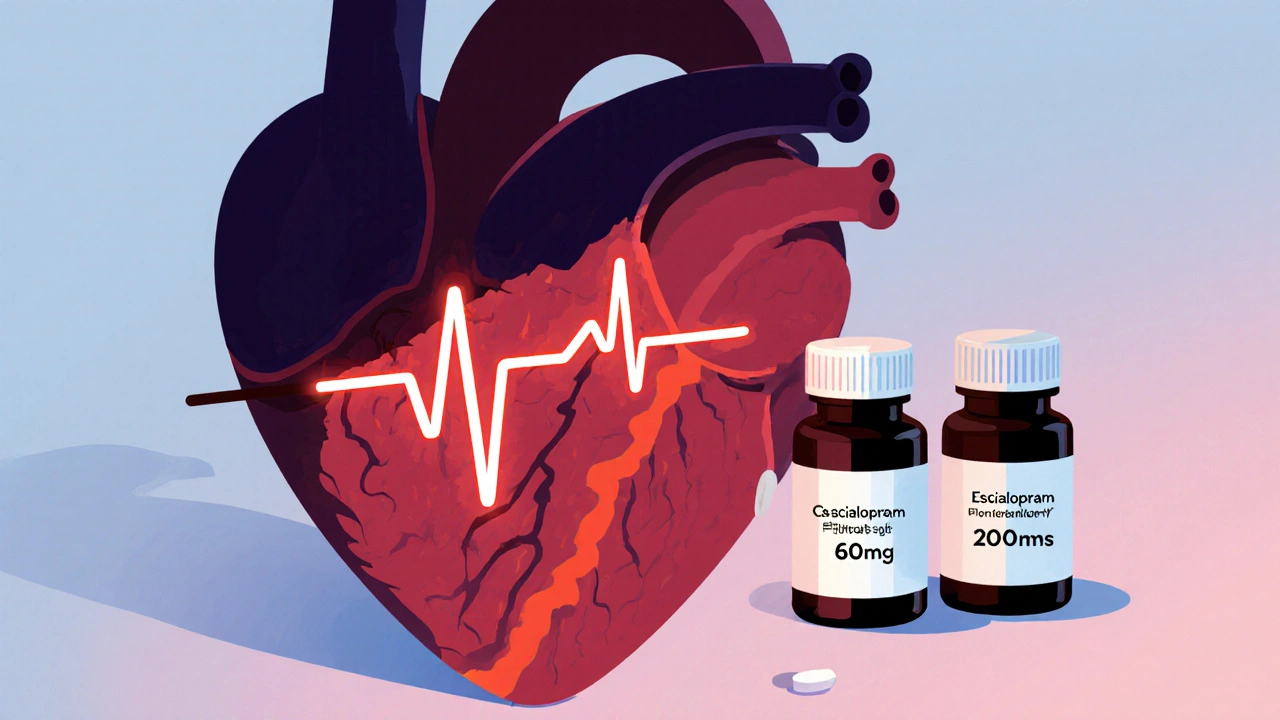QT Prolongation Risk Calculator
This tool estimates the QT prolongation risk of citalopram or escitalopram based on dose, age, and risk factors. It does not replace clinical judgment by a healthcare provider.
When you're prescribed an SSRI for depression or anxiety, you're probably focused on how it will help your mood - not your heart. But for citalopram and escitalopram, the heart matters just as much as the mind. Both drugs work well for treating depression, but they carry a quiet, serious risk: QT prolongation. This isn't a side effect you'll feel. It won't make you dizzy or cause chest pain. But it can trigger a life-threatening heart rhythm called Torsade de Pointes - especially if you're on too high a dose, or if other risk factors are in play.
What QT Prolongation Really Means
Your heart beats because of electrical signals. The QT interval on an ECG measures how long it takes for your heart's lower chambers to recharge between beats. If that interval gets too long, your heart can skip or flutter in a dangerous pattern. A QTc (corrected QT) of 500 milliseconds or more is considered high risk. A jump of 60 milliseconds or more from your baseline also raises concern. Citalopram and escitalopram both block a specific potassium channel in the heart (hERG), which slows down this recharge phase. It's not unique to these drugs - some antibiotics, antifungals, and older antidepressants do the same. But for SSRIs, citalopram and escitalopram are the main ones flagged for this risk.Dose Matters: The Numbers Behind the Risk
The risk isn't the same at every dose. It climbs steadily with higher amounts. Here’s what the data shows:- Citalopram 20 mg/day: QTc increases by about 8.5 milliseconds
- Citalopram 40 mg/day: QTc increases by 12.6 milliseconds
- Citalopram 60 mg/day: QTc increases by 18.5 milliseconds
- Escitalopram 10 mg/day: QTc increases by 4.5 milliseconds
- Escitalopram 20 mg/day: QTc increases by 6.6 milliseconds
- Escitalopram 30 mg/day: QTc increases by 10.7 milliseconds
Why Escitalopram Is Often Preferred
Citalopram is a mix of two mirror-image molecules (enantiomers). Only one of them - the S-enantiomer - is active against serotonin. That’s exactly what escitalopram is: pure S-enantiomer. That means you get the same antidepressant effect with half the total drug load. Because escitalopram doesn’t carry the extra “inactive” molecule, it causes less QT prolongation at equivalent doses. A 20 mg dose of escitalopram is roughly as effective as a 40 mg dose of citalopram - but with a much smaller impact on your heart. Regulators noticed this. In 2011, after reviewing global data, the FDA warned that citalopram doses above 40 mg/day were unsafe. They didn’t issue the same warning for escitalopram - not because it’s risk-free, but because the risk was lower at its maximum approved dose of 20 mg/day.
Who’s at Highest Risk?
Not everyone who takes these drugs needs to worry. But some people are much more vulnerable:- People over 65: Aging slows how your body clears these drugs. That means even a normal dose can build up to dangerous levels.
- Those with existing heart conditions: Previous heart attack, heart failure, or bradycardia (slow heart rate) make you more sensitive.
- People with congenital long QT syndrome: This inherited condition makes your heart extra prone to dangerous rhythms.
- Those taking other QT-prolonging drugs: Antibiotics like azithromycin, antifungals like fluconazole, or even some anti-nausea meds can add up.
- People with low potassium or magnesium: Electrolyte imbalances make QT prolongation worse.
What the Regulators Said - And How It Changed Prescribing
In 2011, the FDA, MHRA (UK), and Medsafe (New Zealand) all issued safety alerts. The message was clear: high doses of citalopram are dangerous. The FDA capped citalopram at 40 mg/day for adults under 65, and 20 mg/day for those over 65. Escitalopram was limited to 20 mg/day for adults and 10 mg/day for older patients. The UK’s MHRA went further - they warned about both drugs. Why? Because even though escitalopram is safer, they didn’t want doctors assuming it was risk-free. They emphasized that no SSRI should be given at high doses without considering cardiac risk. These weren’t just paperwork changes. They reshaped how doctors prescribe. Today, citalopram at 60 mg is rarely seen in clinical practice. Escitalopram at 30 mg is almost never prescribed - not because it’s ineffective, but because the cardiac risk outweighs any benefit.Other Antidepressants - How Do They Compare?
Not all SSRIs carry this risk. Fluoxetine, sertraline, and paroxetine have minimal effect on the QT interval. SNRIs like venlafaxine are low-risk at normal doses - but overdose can be dangerous. Tricyclic antidepressants like amitriptyline and maprotiline are known to prolong QT, and they’re often avoided in older adults or those with heart disease. That’s why many psychiatrists now choose sertraline or escitalopram over citalopram when cardiac risk is a concern. Cost matters - citalopram is cheaper - but if your heart is at risk, paying a bit more for escitalopram makes sense.
Is the Risk Real - Or Just Overblown?
Some experts argue the QT prolongation from these drugs is mostly theoretical. After all, Torsade de Pointes is extremely rare - even with citalopram at 40 mg. The absolute number of cardiac deaths linked to these medications is tiny compared to the millions of people who benefit from them. But that’s not the point. The goal isn’t to eliminate all risk. It’s to avoid avoidable harm. If a lower dose of escitalopram gives you the same mood improvement with half the cardiac risk, why take the bigger risk? Studies show that when doctors follow the updated guidelines - using lower doses, checking electrolytes, avoiding drug combinations - the risk drops to near-zero. The warnings didn’t make these drugs unsafe. They made them safer to use.What You Should Do If You’re Taking One of These
If you’re on citalopram or escitalopram, here’s what to ask your doctor:- What’s my current dose - and is it the lowest effective dose?
- Have I had an ECG recently? (Especially if I’m over 65 or have heart issues.)
- Am I taking any other meds that could add to the risk?
- Should I get my potassium and magnesium levels checked?
Bottom Line: Safer Use Is Possible
Citalopram and escitalopram are still effective, widely used, and generally safe - when used correctly. The QT prolongation risk isn’t a reason to avoid them. It’s a reason to use them wisely. For most people under 65 without heart problems, escitalopram at 10-20 mg/day is a safe, effective choice. Citalopram should be avoided above 20 mg if you’re over 65, and above 40 mg at any age. Always tell your doctor about every other medication you take - including over-the-counter drugs and supplements. The key isn’t fear. It’s awareness. These drugs work. But your heart deserves the same attention as your mood.Can citalopram cause sudden cardiac death?
Citalopram can increase the risk of a dangerous heart rhythm called Torsade de Pointes, which may lead to sudden cardiac arrest - but this is extremely rare. The risk is highest with doses above 40 mg per day, especially in older adults or people with existing heart conditions. Most patients taking citalopram at recommended doses never experience this complication.
Is escitalopram safer than citalopram for the heart?
Yes, escitalopram is generally safer for heart rhythm. Because it’s the pure active form of citalopram, it causes less QT prolongation at equivalent antidepressant doses. At 20 mg, escitalopram has about half the QTc effect of 40 mg citalopram. For patients with cardiac risk factors, escitalopram is often the preferred SSRI.
What’s the maximum safe dose of escitalopram?
The maximum recommended dose of escitalopram is 20 mg per day for adults under 65. For patients over 65, or those with liver problems, the maximum is 10 mg per day. Doses above 20 mg offer no additional antidepressant benefit but increase the risk of QT prolongation.
Do I need an ECG before starting citalopram or escitalopram?
An ECG isn’t required for everyone, but it’s strongly recommended if you’re over 65, have a history of heart disease, are taking other QT-prolonging drugs, or have low potassium/magnesium. If you’re starting citalopram at 40 mg or escitalopram at 20 mg, a baseline ECG helps establish your heart’s normal rhythm before treatment.
Can I take citalopram if I have a family history of long QT syndrome?
No. If you or a close family member has congenital long QT syndrome, citalopram and escitalopram should be avoided entirely. Even low doses can trigger dangerous heart rhythms in people with this inherited condition. Alternative antidepressants like sertraline or fluoxetine are safer choices.
What if I’ve been on 60 mg of citalopram for years - should I stop?
Do not stop suddenly. Talk to your doctor right away. A dose of 60 mg is well above current safety limits and significantly increases your risk of serious heart rhythm problems. Your doctor can help you taper down safely and switch to a lower, safer dose of escitalopram or another antidepressant if needed.



henry mariono
This is one of those posts that makes you pause and actually think about what you're taking. I've been on escitalopram for three years now at 10mg, never even knew about QT prolongation until now. Thanks for laying it out so clearly - no fluff, just facts. I'll ask my doc about an ECG next visit.